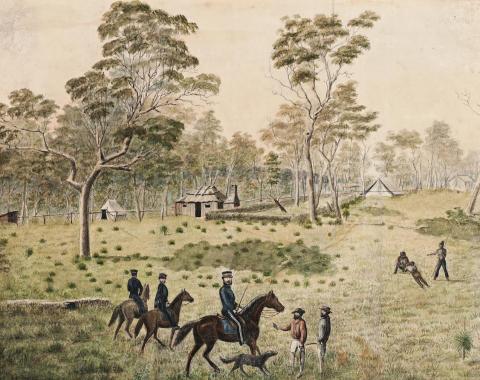MOUNTED POLICE WITH SETTLERS AND ABORIGINES, TOOLOOM, N.S.W., 1860
CONRAD WAGNER
watercolour on paper
22.0 x 28.0 cm
signed, dated and inscribed verso: From Glen / to dearest Gracey. / Sydney 6th may 1861 / Pensez à votre / très attaché / C. Wagner / Tooloom October 30th 1860.
Private collection, London
Private collection, Melbourne
Conrad Wagner was a German-born photographer and scene painter who emigrated to Grafton, New South Wales, in 1856. There was a large expatriate community there and Wagner soon became the Secretary of the Grafton German Club. He ran a photography studio from Princes Street (employing John William Lindt as his apprentice in the 1860s) but retained a love for drawing and sketching which he practiced whenever he could. He can only be described as a competent artist at best, but his work appealed to many citizens in the region and Wagner undertook a range of portrait commissions as a result. These now form an invaluable record of the life and times.
The watercolour on offer here shows an incident on the Tooloom diggings,1 200 km north of Grafton, where gold was first discovered in 1857. It was a relatively rich field attracting some 10,000 miners but was considered to be ‘done up’ by June 1859,2 though a later report in the Clarence and Richmond Examiner reported nuggets were still being found.3 Wagner no doubt travelled there to record the activity photographically but this image reveals his keen eye for other potential drawing subjects. It would seem that Tooloom, like other fields, was dogged by the presence of police extracting fees for the much resented miners’ licences. Such activities led famously to the Eureka Stockade, Ballarat uprising some six years earlier, and tensions between police and miners throughout the country obviously remained. In the middle ground, a group of indigenous Budjalong men have already adopted European trousers but still possess their spears and other implements, whilst in the background the typical gold-digger’s hut of split saplings and bark demonstrates the overwhelming effect of the encroaching miners upon indigenous lands. This drawing by Conrad Wagner is a particularly fine example of its kind and the vibrant colours are the legacy of it having remained folded up in an envelope for many years.
The author thanks Jonathan Dickson of Douglas Stewart Fine Books for assistance in this research.
1. Tooloom was subsequently renamed Urbenville.
2. Clarence and Richmond Examiner, Grafton, New South Wales, June 1859
3. Clarence and Richmond Examiner, Grafton, New South Wales, July 1859
ANDREW GAYNOR
